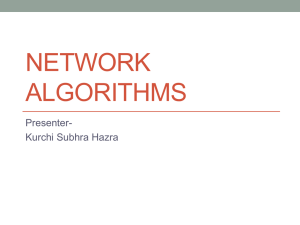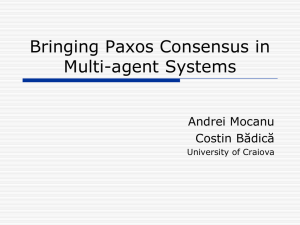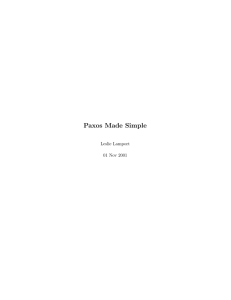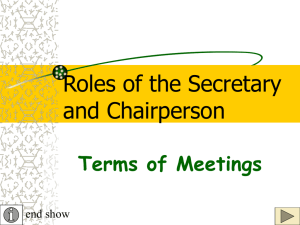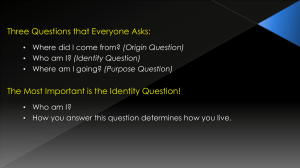slides
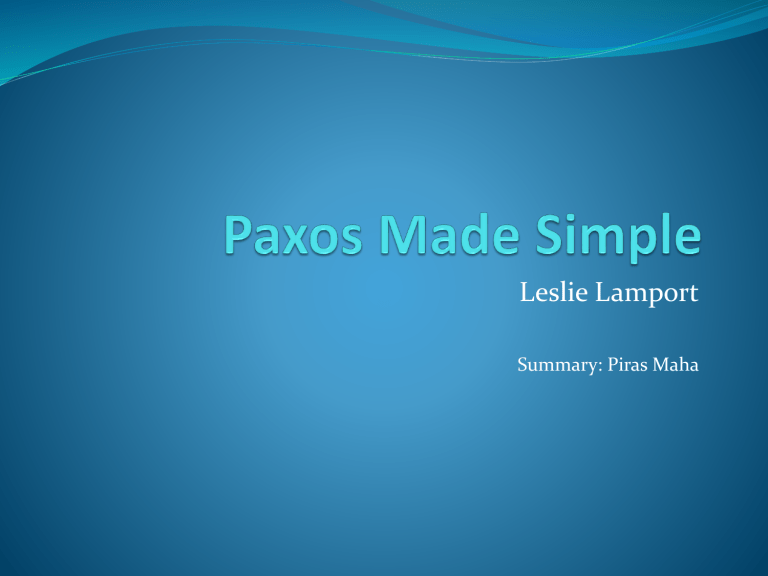
Leslie Lamport
Summary: Piras Maha
Outline
History
Problem
Choosing A Value
Learning
Simple Example
History
Leslie Lamport
Presented in 1990
Almost everyone dismissed it
The first paper was a difficult read, hard to understand
Took 10 years before publication, required almost a complete re-write
Gained popularity really quickly in distributed system
Lots of decomposition and optimizations, still being applied to date
The Problem
Assume a collection of processes
Each process proposes a value
Considered consensus algorithm( chooses a single value is chosen)
If no value is proposed then no value should be chosen
If a value has been chosen processes should be able to learn chosen value
The Problem
Safety requirement for consensus
Only a value proposed may be chosen
Only single value is chosen
Process never learns value has been chosen unless it actually has been
Three roles of algorithm preformed by three classes of agents
Proposers
Acceptors
Learners
The Problem
Agents can communicate with each asynchronously
(through messaging)
Agents operate at arbitrary speed
May fail, may restart (information should be remembered)
Messages may take arbitrary delivery times, can be duplicated, can be lost but not corrupted
Choosing A Value – Simple Logic
A simple method: have one acceptor
A proposer sends a proposal to acceptor
Acceptor chooses first value it receives
Issue: if acceptor fails, make further progress not possible
Choosing A Value – P1
What if we used multiple acceptors?
Proposer sends value to a set of acceptors
An acceptor may accept proposed value
Value chosen if majority (or large enough set of
acceptors) chooses it
In absence of message loss or failure, want a value chosen even if only one value proposed by proposer
P1: An acceptor must accept the first proposal that it receives
Choosing A Value – P1
P1 raises an issue: several values proposed by different proposers , where every accepted a value but no majority
Or two values were proposed and half were chosen by one set of acceptors
Failure of single acceptor could make it impossible to learn which value was chosen
Choosing A Value – P1
P1 and requirement considering value is chosen when accepted by a majority imply acceptor must be allowed to accept multiple proposals
To track the proposals, each proposal consists of proposal number and value
Different proposal would have different numbers
A value is chosen when single proposal with that value is accepted by majority of acceptors
Choosing A Value – P2
Multiple proposals may be chosen but value must be same in all
P2: If a proposal with value v is chosen, then every higher-number proposal that is chosen has value v
This guarantees that only single value will be chosen
Again, to be chosen, proposal must be accepted by at least one acceptor
P2a: If a proposal with a value v is chosen, then every higher-numbered proposal accepted by any acceptor has value v
Choosing A Value
Since communication is asynchronous, a proposal may be chosen with an acceptor c, not received any proposal
At this point if a new proposer issues a higher-number proposal with a different value, P1 requires c to accept, thereby violating P2a
P2b: IF a proposal with value v is chosen then every higher number proposal issued by any proposer has value v
Choosing A Value
Since proposal must be issued before it is accepted,
P2b implies P2a which implies P2
Prove P2
Assume proposal with number m and value v chosen
Any proposal issued with number n, n>m has value v
Using induction on n, can prove n had value v, with additional assumption: every proposal number with a number in the range m to (n-1) has value v
For proposal m to be chosen, a majority of acceptors C, where every acceptor in C has accepted it
Choosing A Value
This m (Hypothesis ) is chosen and it implies:
Every acceptor in C has accepted a proposal with number in the range m ...(n-1) and every proposal with a number in m...(n-1) accepted by any acceptor has value v
Since any set S, with majority acceptors, contains at least one C leads to proposal number n has value v by(leading to) :
P2c: For any v and n, if a proposal with value v and number n is issued, then there is a set S consisting of a majority of acceptors such that either
(a) no acceptor in S has accepted any proposal number less than n
Choosing A Value – Issuing
Proposals
Or (b) v is the value of the highest numbered proposal among all proposals numbered less than n accepted by the acceptors in S
A proposer that wants to issue a proposal numbered n, must learn the highest numbered proposal with number less than n, if any, that has been accepted so far
To do this: a proposer chooses number n, sends request to acceptors asking for response containing
Promise to not accept proposal numbered less than n
Proposal with highest number less than n, that has been accepted
Called: Prepare Request
Choosing A Value – Issuing
Proposals
If proposer receives requested responses from majority, then issue proposal with number n and value v (where v is highest numbered proposal among responses or new number if no proposals reported)
Proposer later sends a request that proposal has been accepted
Choosing A Value - Acceptor
Acceptor can receive two kinds of requests from proposers
Prepare request
Accept request
Can ignore requests
P1a: an acceptor can accept a proposal number n if and only if it has not responded to a prepare request having a number greater than n
With this, a complete algorithm for choosing value
Choosing A Value – Algorithm
Optimization
Consider acceptor receives a prepare request with number n, but already responded to prepare request with number greater than n
Therefore promised not to accept any proposal numbered n
Which means no reason to respond to this request or respond to a request for a for a proposal that was already accepted
Choosing A Value
Now, acceptor only needs to remember the highest – number proposal that was accepted and the number of highest-numbered prepare request which was responded to
Since P2c kept invariant regardless of failures, acceptor must remember this information if failure or restart
Note: proposer can abandon proposal and forget all about it, as long as it doesn’t issue another proposal with same number
Choosing A Value - Algorithm
Phase 1
Proposer sends prepare request with number n to majority of acceptors with proposal number n
If an acceptor receives a prepare request with number n
(this n is greater than any prepare request which it has already responded up until now), then it responds to the request with a promise not to accept any more proposals numbered less than n and with the highest-numbered proposal (if any) that it has accepted
Choosing A Value - Algorithm
Phase 2
If proposer receives response to its prepare request (for example numbered n) from majority of acceptors
Proposer sends accept request to all acceptors with proposal number n (with value v), where v is the value of the highestnumbered proposal from the responses OR is any value, if no responses were heard
If acceptor receives request for proposal number n, it will accept this proposal unless it already responded to a prepare with a number greater than n
Choosing A Value
Multiple proposals can be made
Follows algorithm each time
Proposer can abandon in the middle of protocol
Correctness should be maintained
Sequence with no errors
Learning A Chosen Value
To learn a value is chosen, learner must first know the proposal has been accepted by majority
Obvious solution to let each acceptor respond to all learners (sending proposal)
Good: allows all learners find out about chosen value quickly
Bad: requires each acceptor to respond to each learner
(large number of responses, number of learners x number of acceptors)
Learning A Chosen Value
Another option: have one distinguished learner
Have this learner communicate to all other learners
(which value chosen)
Bad: less reliable, if distinguished learner fails
Requires extra round for all learners to discover chosen value
Good: requires less responses( number of acceptors + number of learners)
Learning A Chosen Value
Next approach would be to have a set of distinguished learners
Acceptors send acceptances to the set of distinguished learners
Larger the set, more reliable but adds complexity/greater communication
Progress
Consider: proposer p, completes phase 1, proposal number n1
Another proposer q, then completes phase 1 for proposal number n2, n2>n1
Proposer p’s accept request for n1 are ignored since acceptors promised not to accept proposal number< n2
Then p, begins and completes phase 1 for n3, n3>n2
Therefore q’s phase 2 accept requests ignored,
...
Progress
Use distinguished proposer, only one to try issuing proposals
If distinguished proposer communicates with majority of acceptors, using proposal number greater than any already used, then it can succeed issuing an accepted proposal
Abandon proposal then trying again if it learns of new request with higher proposal number, this distinguished proposer will eventually choose high enough proposal number
Progress
If enough of proposers, acceptors and communication network is working properly, electing single distinguished proposer can lead to liveness
Reliable algorithm for electing distinguished proposer may require randomness or real-time (based on research results)
The Implementation
Paxos algorithm assumes network of processes
In its heart, considered consensus algorithm, with agents playing proposer, acceptor, learner
Leader is chosen, plays distinguished proposer and learner
Paxos consensus algorithm requests and responses sent as ordinary messages
Stable storage (alive during failure) contains information acceptor must remember
Acceptor records in stable storage before sending response
State Machine Implementation
Use collection of servers, each one implementing state machine independently
Deterministic
Guarantee execution osfsame sequence of state machine commands
Another Look
To put it simple terms: Paxos is used to have consistency (ordering of semantics) on a platform with multiple machines
Why is this important?
If ordering is jumbled, the meaning is lost
Unreliable
Could cause safety issues
Another Look - Example
Jane has $0 in her account
Joe sends $100 to Jane
When Jane is notified she received $100, she sends $50 cheque to CRA
CRA cashs the cheque and spends it on something useless
Without consistent ordering, each machine might view these in different order
Author QA
What would you like to convey to current and future researchers and practitioners?
Don’t pay attention to pedantic old farts like me telling you what to do.
What are the most important lessons you’ve learned in your career?
My career has been idiosyncratic. Any meaningful lessons I could draw from it would, at best, apply to people starting their careers 30 years ago.
Ref: http://research.microsoft.com/en-us/um/people/lamport/pubs/ds-interview.pdf
References
http://ayende.com/blog/4496/paxos-enlightment
http://www.inf.usi.ch/faculty/pedone/MScThesis/mar co.pdf
http://the-paper-trail.org/blog/?p=173
Paxos Made Simple by Leslie Lamport (2001)
